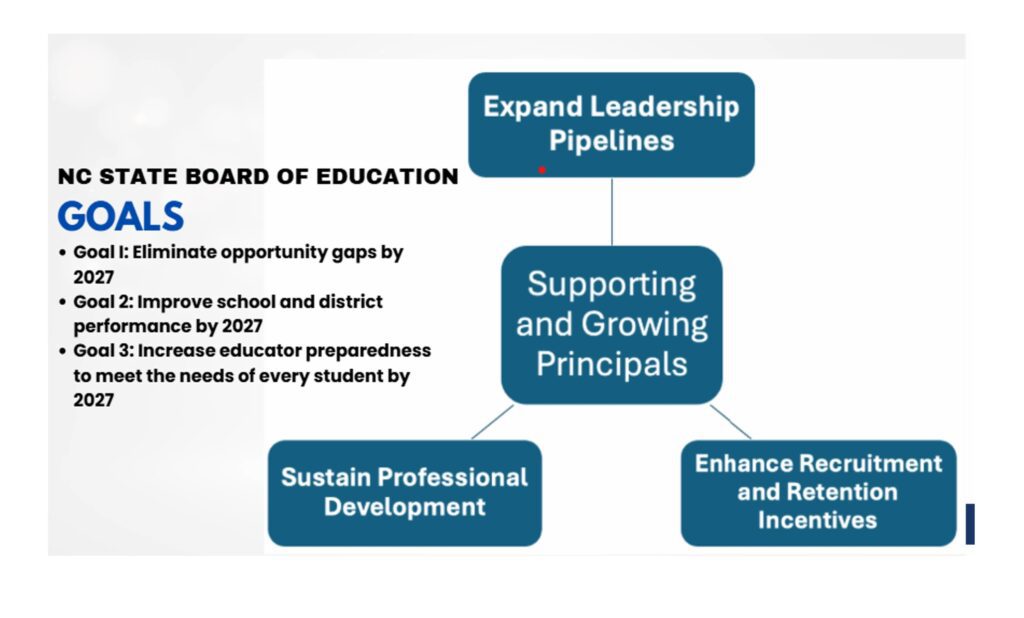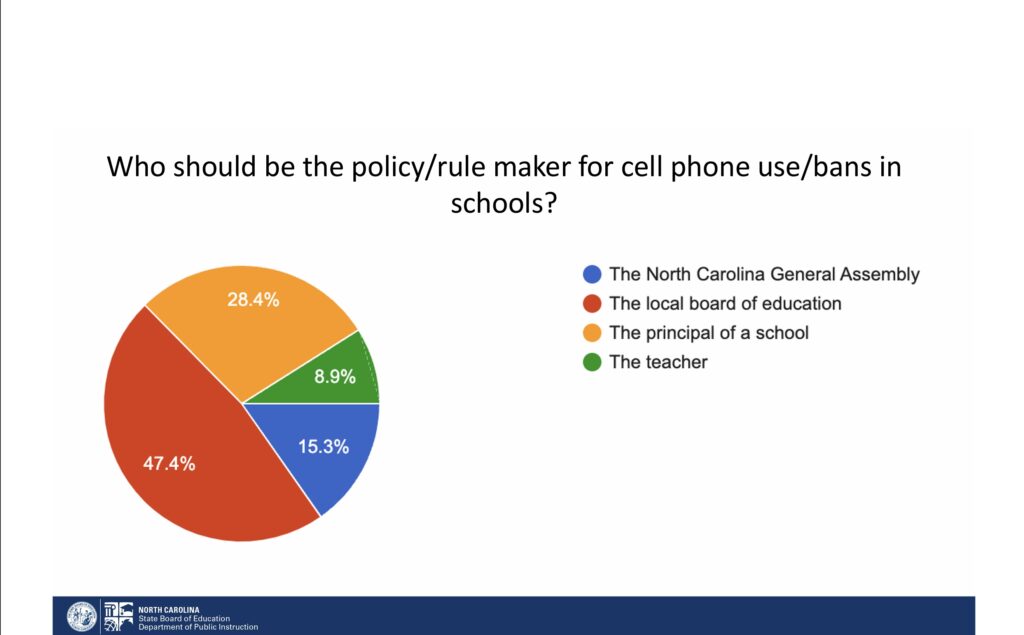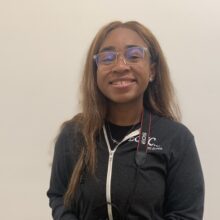The education policy-making process in North Carolina can seem complex, even to the State Board of Education members themselves.
“In fact, it’s often confusing and frustrating – the variety of laws and policies don’t always seem to align,” Eric Davis, the Board’s chair, said. “They typically inhibit the distribution of resources and place undue burdens on our teachers and students, and yet, that system works best when we work together. Instead of domination, we seek collaboration.”
To begin their biannual planning and work session in December, the Board heard presentations from different stakeholders in the policy drafting process to learn how to leverage their partnerships.
The ‘carrot-flavored’ stick
A bill regarding cellphone use in schools that was introduced in the last legislative session was mentioned by Sen. Jay Chaudhuri, D-Wake, and Sen. Jim Burgin, R-Harnett, before the Board as an example of action they take once an issue in education gets on their radar.
To start, Chaudhuri said there is no monopoly on good ideas. The state senator said that outside of the Board and the Department of Public Instruction (DPI), there are a number of education groups they could consult with.
“And I think what we’re doing with the cellphone policy is a good example of kind of touching base and taking the temperature on folks,” Chaudhuri said. “Peter Duvall, who’s my legislative assistant here, has been on the phone with a number of groups, and had a conversation with the North Carolina PTA about the cell phone policy. So trying to make sure you gather that information and conversations with stakeholders becomes really important.”
Burgin said there should be good relationships in place before advocating for policy starts. He also said there should be consistency, as well as a balance between providing funding and incentives to schools opposed to imposing a strict ban or policy.
“Everybody talks about the carrot and stick. I always say, find the carrot-flavored stick. And so that’s what we need to fund, is the carrot-flavored stick to use, and I think there’s a way to do it,” Burgin said.
District-wide implementation
In this instance, the Board heard from three school districts — Brunswick, Union, and Granville counties — on their approach to cellphone use policies.
Davis asked what the state should or should not provide, other than funding, to support districts in implementing policies.
“I’ll just begin by simply supporting us. I know that when my board of education got unanimously behind me and our teachers in laying down the law, so to speak, it made a huge difference. We were able to communicate that far and wide to our community, our parents. And it wasn’t just some arbitrary thing that was happening at a classroom level,” Stan Winborne, superintendent of Granville County Schools, said. “So I think the message coming from a high unified voice makes a huge difference. It’s setting the tone and creating a culture about the expectations that will make a difference.”
Dan Cole, superintendent of Brunswick County Schools, said decisions should be based on what’s best for students and “following the science, following the research.”
More on school cellphone policies
Building by building
Some changes have to be set and agreed on at a school level before they affect the student.
In the case of cellphone use, Chaudhuri said that at his children’s school, for instance, they have to look at social media to keep up with extracurricular activities. It would be up to school administrators to come up with a system that does not require students to have a cellphone to get the information.
The Board heard a presentation from Beckie Spears, Donna Bledsoe, and Patrick Greene, Wells Fargo Principal of the Year recipients for 2024, 2023, and 2024, respectively.
“School leaders have to be teacher-focused to be student-centered,” Bledsoe, a principal in Surry County Schools, said.
Greene, a principal in Greene County Schools, said each of the Board’s goals flows through a principal if it’s going to be effective. He also said they need to expand the leadership pipeline to become a principal.
The presenters emphasized how principal leadership can be leveraged to reach the Board’s goals.
“I think support is really important. I know, as a principal, the support of my superintendent and us being able to set our procedures for the way that best works for our community is really important,” Kim Fissenne, a principal in Union County Schools, said.
Fissene said that while local control of policy and procedures is important for teacher and parent buy-in, having state support also helps.
Spears, a principal in Wilkes County Schools, said the greatest impact on student success is the teacher in the classroom. And then what keeps teachers in the classroom is the school principal.
“It’s really, truly an opportunity for us to lead change for this next generation of students, because of all of the traits that we teach students, of all the durable skills — adaptability is the one that in this job, that’s got to be on the top of your list, because it’s an ever-changing role, an ever-changing job, and it’s an opportunity for our state to invest in our principals,” Spears said. “Which ultimately impacts those teachers and those students. We touch every single member of the school community, and if any one thing is wrong on anyone’s day, we’re often the person they come to.”

Classroom by classroom
Before looking at policy or doing research to support a future policy, Board member Catty Moore said they have to look at what is happening at a local level.
“The further you are away from where it’s being implemented, the more it frays at the edges and does not end up with what you thought you started out with,” Moore said. “So I think that’s going to be really important in terms of how we collect information that helps us develop what the framework is around the expectations, or the non-negotiables, or the guardrails, as you mentioned, and how those are created at the system level, with input from teachers, I think, and even students, quite frankly.”
Ian House, the Board’s student advisor, said that many students do want a voice in decision-making. He said that students in his home county and others that he has spoken with have felt “alienated” from the process.
According to a survey administered by House, students are not responding to policies such as cellphone bans due to factors such as inconsistency from classroom-to-classroom, lack of consequences, and the restrictions increasing their desire to violate the policy.
In a survey for teachers presented by House and Julie Pittman, who at the time served as special advisor to the superintendent, most respondents believed that local school boards should form the policies for things such as cell phone use.

Pittman said she has seen different districts include students in decisions with principals and local school boards. She said leaving them out of the decision-making process means that policy is being done to them and not for them.
“I think that’s why a lot of students disengage in school, because they don’t feel a part of the process. They feel a part of the product. And that is a way that we’re disenfranchising students from a very early age,” Pittman said.
External partnerships
Board members and presenters discussed the need to reach out to partners outside of the education sphere in order to improve the lives of the students they serve. One instance of this is a partnership with the state Department of Health and Human Services (DHHS).
This year, DHHS announced a $7 million investment from the Centers for Medicare and Medicaid Services in school-based behavioral health services, which can be administered via telehealth and school-based health centers. School-based health centers are located near middle and high schools with the goal of providing preventative services to students while increasing their readiness to learn. It is also a part of a nationwide initiative to expand access to care for children eligible for Medicaid or the Children’s Health Insurance Program.
“It’s so important that DPI and DHHS work together. Because when we think about what it is really going to take for schools to take advantage of Medicaid funding and expand their services, we’re not just talking about Medicaid policy and we’re not just talking about finding providers. We’re talking about school administrators who really understand the opportunity,” Hanaleah Levy Hoberman, director of child and family strategy at DHHS, said. “… So this is something that really requires DPI expertise and relationships at the table with school administrators and school staff to do that work while we support them.”





